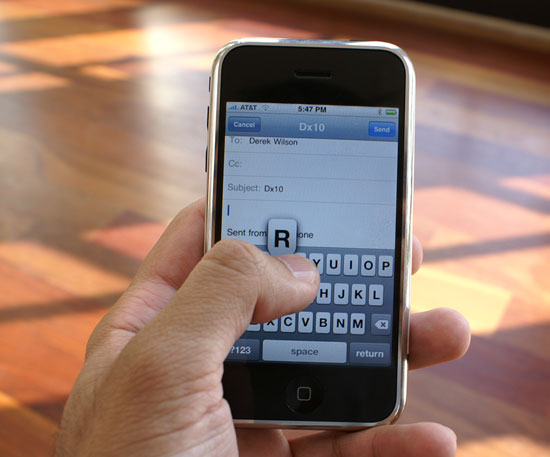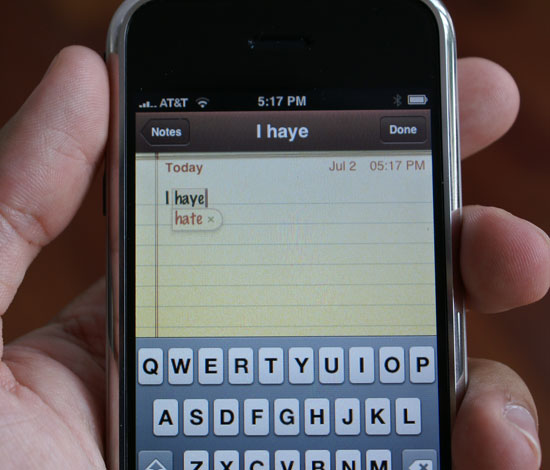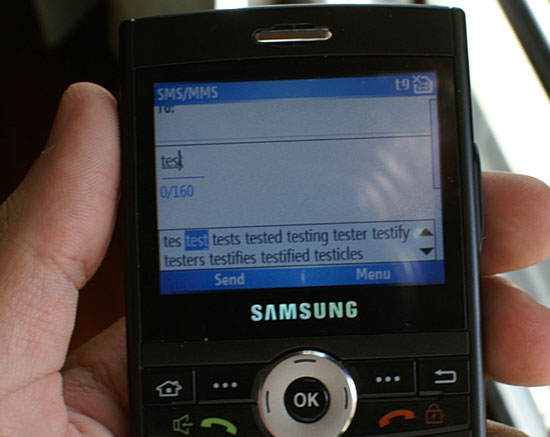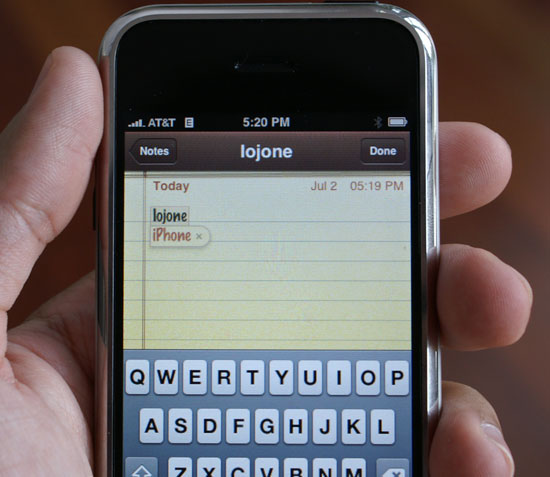Apple's iPhone: The Future is Here
by Anand Lal Shimpi on July 2, 2007 6:13 PM EST- Posted in
- Smartphones
- Mobile
As predictable as what happened next may be, its truth is undeniable: I actually got better with the iPhone's keyboard. I wasn't as fast as I was on my Blackberry or even the Blackjack, but I was getting there and typing on the phone no longer made me want to kill myself with a SIM card.
There are really two tricks to getting reasonably fast with the keyboard, and Apple is very forthcoming with both:
1) Start with your index finger alone (give your thumbs the week off), and
2) Trust the auto correction
Using the index finger is important for one main reason: it's smaller than your thumb. Just as the cramped keyboard is an issue on the Blackjack and Curve, it's an issue on the iPhone. Since there are no distinct divisions between keys, it's very easy to cross boundaries and select a letter you didn't intend to. Whenever you tap a key, the key itself will get bigger to show you what you've just selected, hopefully exposing itself from beneath your finger. If you happen to select the wrong key, your initial instinct will be to delete and try again but that's not necessarily the best reaction with the iPhone as you'll soon see.

The iPhone will make you feel like you've got the fattest thumbs ever
With my index finger, I'm accurate and fast in typing on the iPhone. On my best days you'd swear a room full of monkeys were churning out a copy of Macbeth, that being said, I'm in desperate need of mastering two thumbed typing. Not only does typing long emails with a single index finger grow tiring, two thumbs are necessary to even remain competitive with typing speeds on regular qwerty keyboard devices.
I'm guessing the trick to mastering thumb typing is deliberate placement of your thumbs over the keys you wish to strike. Although your thumb is bigger than your index finger, the part of your thumb that actually triggers the keystroke isn't that much larger. The main issues seem to be that the thumb's contact patch is located in a different area, and the thumb covers up more of the keyboard, making it more difficult to 1) orient and 2) trust yourself, when typing. As you can probably guess, I'm still struggling with thumbs, but it looks like there's still room to grow in typing efficiency on the iPhone.
The iPhone does its best to replace tactile feedback with aural response; you get a rewarding typewriter keystroke sound every time you hit a key on the keyboard (you can disable this if you hate it). The sound is rewarding in the sense that once you actually get fast at typing, it sounds like your pounding out your fifth novel on your iPhone, and if you thrive on feelings of accomplishment like yours truly, it'll help you get better. It's like a personal trainer cheering you on as you work out, the sounds keep coming as long as you keep hitting keys, they don't care if you hit the wrong ones or not, and that's where the second trick comes in.
The early previews and reviews of the iPhone praised its autocorrecting capabilities, which I truly didn't understand because predictive text input has been around for ages. From a distance, that's all the iPhone appeared to have, a slightly cleaner interface to T9. On the second day of using the iPhone, I finally understood what all the fuss was about.

When you're entering text, the iPhone compares what you're typing to its built in dictionary and suggest words that it thinks you are trying to type. For example, if you are typing the word incredible the iPhone will figure it out once you've typed incredibl and suggest the full word. Hitting space at this point will accept the dictionary's suggestion, saving you a keystroke.

T9 in action
The first difference between the iPhone and some T9 based systems (e.g. the Blackjack) is that the iPhone provides a single suggestion while you're typing. If you enable T9 on the Blackjack, you lose some of your screen to a two-line suggestion of possible words you could be trying to type, which changes dynamically as you type away. The end result is a distracting element on the screen that adds marginal functionality on a device with a full qwerty keyboard vs. the iPhone method that remains nonintrusive.

If you don't like the iPhone's suggestion, simply tap the suggested word and it'll disappear. Note that just like T9 based systems, the iPhone's dictionary will grow based on your typing habits; proper nouns and other words will eventually start appearing as suggestions as you type them more frequently.
Both the T9 and iPhone approaches take some getting used to if you are a qwerty Blackberry user who isn't used to such aids, but the iPhone system has a gentler learning curve thanks to its simplicity.
In addition to looking at the word you're typing, iPhone also looks at the keys you're hitting and the proximity of those keys to other keys that you may have actually wanted to hit instead. For example, the word iPhone comes preloaded into the dictionary, the device doesn't have to learn it. But if, while typing furiously with your index finger, you lose your bearings and type iogonr instead (the o key is right next to the p key, the g key is right next to h, and and r is right next to e), the iPhone will mathematically determine that although iogonr could be a word, it's also possible that you just fouled up your finger placement and meant to type iPhone. The software will suggest iPhone as a correction and all you have to do is hit space to accept it.
When Apple recommends that you trust the intelligence of the device, it's this analysis of finger placement that you need to trust. When typing, you know what keys you meant to hit, Apple's iPhone tries its best to figure that out as well (it doesn't like to be yelled at, so it tries really hard).










85 Comments
View All Comments
rcc - Tuesday, July 3, 2007 - link
If there is no GPS hardware built into a device, 3rd party software won't help. You have to have the hardware receiver built in.
Locutus465 - Wednesday, July 4, 2007 - link
Fortunetly by law every new phone activated as of 2005 must have built in GPS for E-911.. Just one small baby step from there repurposes that GPS for coolness... My i720 allows this.strikeback03 - Thursday, July 5, 2007 - link
Doesn't the law simply require the carrier to be able to determine the location of the phone, but not specify how? Allowing the carriers to determine by distance to cell towers instead of GPS?Locutus465 - Thursday, July 5, 2007 - link
I beleive GPS is required... At least this is what I was told by a Verizon rep that refused to activate an older phone I had.Cygni - Thursday, July 5, 2007 - link
GPS is not required by law, yet. Location support IS required, but is already present on nearly every phone made in the last 3 years.plinden - Tuesday, July 3, 2007 - link
Leo Laporte in one of his podcasts this weekend mentioned that he heard there is an SDK for the iPhone that's ready for OS X but not Windows, but Apple (ie Jobs) wants to release both versions at the same time, hence the delay.
That's just a rumor, but it's almost certain there'll be an SDK at some point, although it's extremely likely, if not certain, that developers will have to go through Apple to get their apps published to the iPhone (ie via iTunes).
Give it six months, like I'm doing. I'll likely get the 16GB version with 3G when it's available.
Locutus465 - Tuesday, July 3, 2007 - link
There will need to be good 3rd party support for me to even consider it. There'll also need to be a good (and inexpensive) all in one chat client. And Mahjoong, that's totally a requirement.sviola - Tuesday, July 3, 2007 - link
You should check the Nokia N95, it has the built-in GPS, altough it runs Symbian OS.Locutus465 - Tuesday, July 3, 2007 - link
Well yes, my phone has built in GPS hardware as well (as do all phone inc. iPhone). It's just missing the app + maps (unless you're sayind the nokia comes with software + maps which would be the bomb). So I would just need that part of the equation. As a matter of fact the Samsung i720 also allows you to use the phone as a plain old GPS device, so really if I wanted to I could potentially blue tooth it to a laptop for instance and go that route.Locutus465 - Tuesday, July 3, 2007 - link
Oh yeah, on the i720 to set an MP3 as your ring tone you just need to browse to it in flie explorer, tap and hold ("right click" in Windows Mobile) and select "Set as ringtone" :)Automatically copies to \Windows\Rings and sets the song as your ringtone :D